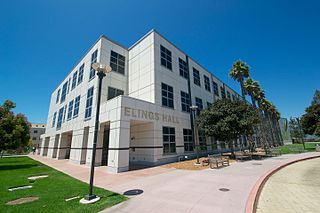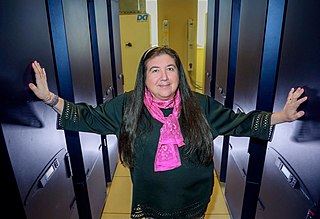
Iowa State University of Science and Technology is a public land-grant research university in Ames, Iowa. Founded in 1858 as the Iowa Agricultural College and Model Farm, Iowa State became one of the nation's first designated land-grant institutions when the Iowa Legislature accepted the provisions of the 1862 Morrill Act on September 11, 1862, making Iowa the first state in the nation to do so. On July 4, 1959, the college was officially renamed Iowa State University of Science and Technology.

Virtual reality (VR) is a simulated experience that employs pose tracking and 3D near-eye displays to give the user an immersive feel of a virtual world. Applications of virtual reality include entertainment, education and business. Other distinct types of VR-style technology include augmented reality and mixed reality, sometimes referred to as extended reality or XR, although definitions are currently changing due to the nascence of the industry.

Mixed reality (MR) is a term used to describe the merging of a real-world environment and a computer-generated one. Physical and virtual objects may co-exist in mixed reality environments and interact in real time.

Immersion into virtual reality (VR) is a perception of being physically present in a non-physical world. The perception is created by surrounding the user of the VR system in images, sound or other stimuli that provide an engrossing total environment.
A projection augmented model is an element sometimes employed in virtual reality systems. It consists of a physical three-dimensional model onto which a computer image is projected to create a realistic looking object. Importantly, the physical model is the same geometric shape as the object that the PA model depicts.
Anind Dey is a computer scientist. He is the Dean of the University of Washington Information School. Dey is formerly the director of the Human-Computer Interaction Institute at Carnegie Mellon University. His research interests lie at the intersection of human–computer interaction and ubiquitous computing, focusing on how to make novel technologies more usable and useful. In particular, he builds tools that make it easier to build useful ubiquitous computing applications and supporting end users in controlling their ubiquitous computing systems.

The California Institute for Telecommunications and Information Technology (Calit2, previously Cal(IT)2), also referred to as the Qualcomm Institute (QI) at its San Diego branch, is a $400 million academic research institution jointly run by the University of California San Diego (UC San Diego) and the University of California, Irvine (UCI); in January 2022, plans were announced to add University of California, Riverside to the consortium. Calit2 was established in 2000 as one of the four UC Gray Davis Institutes for Science and Innovation. As a multidisciplinary research institution, it is conducting research discovering new ways in which emerging technologies can improve the state's economy and citizens' quality of life. Keeping in mind its goal of addressing large-scale societal issues, Calit2 extends beyond education and research by also focusing on the development and deployment of prototype infrastructure for testing new solutions in real-world environments. Calit2 also provides an academic research environment in which students can work alongside industry professionals to take part in conducting research and prototyping and testing new technologies.

The AlloSphere is a research facility in a theatre-like pavilion in a spherical shape, of opaque material, used to project computer-generated imagery and sounds. Included are GIS, scientific, artistic, and other information. Located at the University of California, Santa Barbara (UCSB) the AlloSphere grew out of the schools of electrical engineering and computer science, and the Media Arts & Technology program at UCSB.

Astronaut training describes the complex process of preparing astronauts in regions around the world for their space missions before, during and after the flight, which includes medical tests, physical training, extra-vehicular activity (EVA) training, procedure training, rehabilitation process, as well as training on experiments they will accomplish during their stay in space.
Liquid Image Corporation was a Winnipeg-based company that manufactured head-mounted displays. The company formed in 1992 by Tony Havelka, David Collette and Shannon O'Brien. Liquid Image was started in Winnipeg, MB in response to the emergence of a market for virtual reality technology. Funding as provided by a group of local angels and the first office was in the attic of Tony Havelka.

Carolina Cruz-Neira is a Spanish-Venezuelan-American computer engineer, researcher, designer, educator, and a pioneer of virtual reality (VR). She is known for inventing the cave automatic virtual environment (CAVE). She previously worked at Iowa State University (ISU), University of Louisiana at Lafayette, University of Arkansas at Little Rock, and she is currently an Agere Chair Professor at University of Central Florida (UCF).
uSens, Inc. is a Silicon Valley startup founded in 2014 in San Jose, California. The company's core team includes researchers and developers who builds interactive and immersive computer-vision tracking solutions. The uSens team has extensive experience in artificial intelligence (AI), computer vision, 3D Human–computer interaction (HCI) technology and augmented reality and virtual reality. uSens has been applying computer vision and AI technologies in AR/VR, Automotive and smartphones.

Franz Fischnaller is a new media artist and transdisciplinary researcher. He is recognized for the creation of his digital, virtual reality and interactive art installations works across the fields of art, technology, humanities and cultural heritage.
Virtual reality (VR) is a computer application which allows users to experience immersive, three dimensional visual and audio simulations. According to Pinho (2004), virtual reality is characterized by immersion in the 3D world, interaction with virtual objects, and involvement in exploring the virtual environment. The feasibility of the virtual reality in education has been debated due to several obstacles such as affordability of VR software and hardware. The psychological effects of virtual reality are also a negative consideration. However, recent technological progress has made VR more viable and promise new learning models and styles for students. These facets of virtual reality have found applications within the primary education sphere in enhancing student learning, increasing engagement, and creating new opportunities for addressing learning preferences.

A virtual reality game or VR games is a video game played on virtual reality (VR) hardware. Most VR games are based on player immersion, typically through head-mounted display unit or headset with stereoscopic displays and one or more controllers.

Virtual reality applications are applications that make use of virtual reality (VR), an immersive sensory experience that digitally simulates a virtual environment. Applications have been developed in a variety of domains, such as education, architectural and urban design, digital marketing and activism, engineering and robotics, entertainment, virtual communities, fine arts, healthcare and clinical therapies, heritage and archaeology, occupational safety, social science and psychology.
Stefania Serafin is a professor at the Department of Architecture, Design and Media technology at Aalborg University in Copenhagen.
Immersive learning is a learning method which students being immersed into a virtual dialogue, the feeling of presence is used as an evidence of getting immersed. The virtual dialogue can be created by two ways, the usage of virtual technics, and the narrative like reading a book. The motivations of using virtual reality (VR) for teaching contain: learning efficiency, time problems, physical inaccessibility, limits due to a dangerous situation and ethical problems.
Ibrahim "Abe" Moussa Baggili is a cybersecurity and digital forensics scientist at Louisiana State University with a joint appointment between the college of engineering and the Center for Computation and Technology. Before that, he was the founder and director of the Connecticut Institute of Technology (CIT) at the University of New Haven. Baggili was also a full professor and Elder Family Endowed Chair at UNewHaven. He has a B.S., M.S., and Ph.D. in Computer and Information Technology from Purdue University's Purdue Polytechnic Institute. Baggili is a Jordanian/Arab American first generation college graduate and a well-known scientist in the domain of Cyber Forensics and Cybersecurity with seminal peer-reviewed work in the areas of Virtual Reality Forensics (VR) and security, mobile device forensics and security, application forensics, drone forensics and memory forensics.










